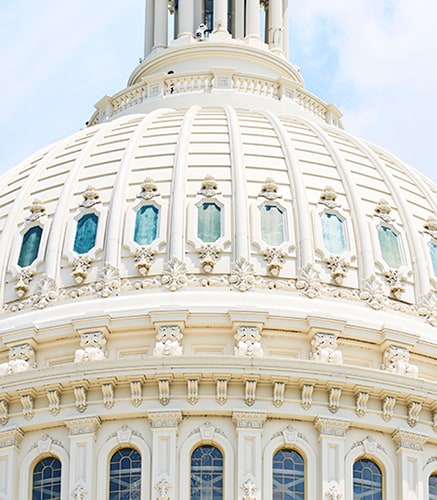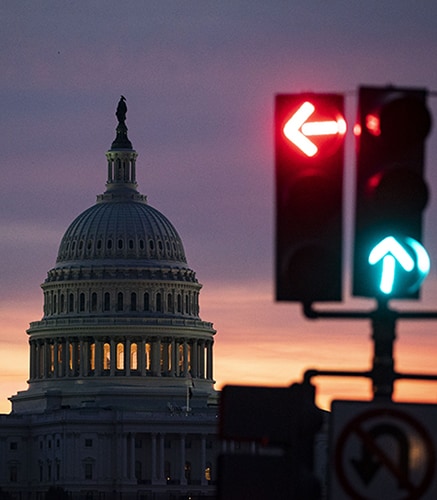Tax News You Can Use | For Professional Advisors
Jane Ditelberg, Director of Tax Planning
August 25, 2025
As taxpayers and their advisors digest the One Big Beautiful Bill Act (OBBBA), the emerging advice is to make charitable contributions in 2025 before the law’s provisions become effective. There are two provisions of OBBBA that, combined, can have a significant effect on the size of the income tax charitable deduction and the tax benefit from a taxpayer’s donation. In 2026, all taxpayers who itemize deductions will be able to deduct only that portion of their charitable contributions that exceeds 0.5% of their modified adjusted gross income (MAGI). Also beginning in 2026, those taxpayers in the 37% bracket (single filers with taxable income over $626,350 or married taxpayers filing jointly with taxable income over $751,600) will have a portion of all itemized deductions disallowed. What does this mean and how can taxpayers plan? Let’s start with the new rules themselves.
What Is The “Shave” Or The “Floor?”
The provision that commentators have dubbed the “shave” or the “floor” is limited to charitable contributions by taxpayers who itemize. It denies a charitable contribution deduction for donations up to 0.5% of the taxpayer’s MAGI. For a taxpayer with $500,000 of MAGI, the first $2,500 in charitable contributions would not be deductible. This would mean paying an additional $875 (using the 35% bracket) in federal income tax next year that would not be paid if the contribution were made in 2025.
The floor applies to all taxpayers regardless of income level, although the amount of deductions shaved is based on each taxpayer’s MAGI. The only exception to this floor is for cash contributions to public charities (other than donor advised funds (DAFs) and certain supporting organizations) that qualify for the deduction for non-itemizers. This deduction of up to $1,000 for single filers and $2,000 for married taxpayers filing jointly is available beginning in 2026.
What Is The “Haircut” Or The “Ceiling?”
Beginning in 2026, the OBBBA adds another wrinkle for taxpayers whose income puts them in the 37% bracket: A portion of all their itemized deductions, including charitable donation deductions and other itemized deductions like state and local taxes and mortgage interest, is disallowed. The formula determining the amount of the disallowance is equal to 2/37 multiplied by the lesser of (a) the total amount of itemized deductions claimed for the year or (b) the amount of income being taxed at the highest marginal rate. It may be easier to understand this by looking at some examples:
Example 1
Erika is a single taxpayer with MAGI of $700,000 in 2026. For 2026, Erika has the following itemized deductions:
| Deduction | Gross Amount | Reduction (reason) | Net (before haircut) |
|---|---|---|---|
| Taxes | $65,000 | $55,000 (SALT cap) | $10,000 |
| Mortgage interest | $50,000 | None | $50,000 |
| Charitable donations | $150,000 | $3,500 (floor) | $146,500 |
| TOTAL | $265,000 | $58,500 | $206,500 |
Due to Erika’s income, a portion of her itemized deductions will be disallowed. The 37% bracket starts at $626,350. Therefore, the disallowance is 2/37 multiplied by the lesser of (a) $73,650, which is the amount of Erika’s income taxed at the 37% marginal rate, or (b) $206,500, which is the net itemized deductions. Here, $73,650 is the lower number, so $3,981 of itemized deductions will be disallowed. This means that, due to the “shave and a haircut” rules, Erika will be entitled to deduct only $202,519 of the $265,000 spent on deductible items.
Example 2
Brennan and Isabel are a married couple with $2 million of MAGI and the following deductions in 2026:
| Deduction | Gross Amount | Reduction (reason) | Net (before haircut) |
|---|---|---|---|
| Taxes | $200,000 | $190,000 (SALT cap) | $10,000 |
| Mortgage Interest | $85,000 | $57,000 (limit on mortgage size) | $28,000 |
| Investment Interest | $200,000 | None | $200,000 |
| Casualty Loss (hurricane damage) | $300,000 | none if declared disaster | $300,000 |
| Charitable donations | $200,000 | $10,000 (floor) | $190,000 |
| TOTAL | $985,000 | $257,000 | $728,000 |
In this case, $1,248,400 of Brennan’s and Isabel’s income is taxed at the 37% rate and their net itemized deductions are $728,000: Therefore, the lower number of $728,000 is applicable. Of these deductions, $39,351 will be disallowed by the ceiling. This means that Brennan and Isabel will be able to deduct $688,649 of the $985,000 they spent on deductible items.
Example 3:
Katie is single and has MAGI of $400,000 in 2026. Her only itemized deduction is a charitable contribution of $50,000. While the haircut rule does not apply to Katie because she is not in the 37% tax bracket, the shave rule does apply. Katie is only allowed to deduct the amount of her charitable contribution that exceeds 0.5% of her MAGI. The floor for Katie is $2,000, so she may deduct only $48,000.
Example 4:
Jacob is single and has MAGI of $100,000 in 2026. He plans to take the standard deduction, but he has donated $5,000 to charity. He will be entitled to a charitable donation deduction of $1,000 in 2026, which is not subject to the shave or haircut rules. This is a deduction he would not have been entitled to for a gift made in 2025.
What Should Charitably Minded Taxpayers Do?
One option for taxpayers with charitable intent is to accelerate gifts into 2025, before “the shave and a haircut” rules go into effect. Those who make charitable gifts in 2025 may get a higher tax benefit from their contributions if they itemize their deductions. The following table shows how the taxpayers from the examples above would fare if they had the same income and deductions in 2025 and 2026.
| 2026 | 2025 | Difference | Benefit of Accelerating | |
|---|---|---|---|---|
| Erika | $202,519 | $205,000 | $3,419 | $1,265 |
| Brennan and Isabel | $688,649 | $738,000 | $49,351 | $18,260 |
| Katie | $48,000 | $50,000 | $2,000 | $700 |
| Jacob | $1,000 | $0 | ($1,000) | none (penalty) |
The first two taxpayers, who are subject to the ceiling and floor, get additional tax benefits by making their charitable gifts in 2025 instead of 2026, as the disallowance does not apply in 2025. Even Katie, who is subject to the floor but not the ceiling, is better off making her donation in 2025. However, for taxpayers like Jacob who take the standard deduction, they lose the $1,000 charitable deduction for non-itemizers if they make their donation in 2025., so they would be better off by making the gift in 2026.
Planning Ahead Can Help
Some taxpayers may want to consider pre-funding their planned charitable gifts for the next few years. They can make outright gifts, or they may make a single gift to a private foundation or DAF in 2025 to be distributed over time. The taxpayers get the tax benefit now, when no part will be disallowed.
Example 5:
Grant and Lily each pledged to give $200,000 to the local hospital between 2025 and 2028. Each of them has annual income of $1 million. Grant plans to make four separate annual gifts, and Lily plans to make a $200,000 gift in 2025 to satisfy her entire pledge. As the following table of tax benefits from their donations illustrates, Grant’s tax benefit would be 9% lower than Lily’s for the same donation.
| GRANT | LILY | |
|---|---|---|
| 2025 | $18,500 | $74,000 |
| 2026 | $15,750 | $0 |
| 2027 | $15,750 | $0 |
| 2028 | $15,750 | $0 |
| TOTAL | $65,750 | $74,000 |
Even if a taxpayer does not have a specific charitable donation plan in mind for the next five years, they can accelerate the donation into 2025 by using a DAF or private foundation.
Example 6:
Lou generally makes about $100,000 in charitable contributions each year, but he typically chooses the recipients at the end of each year based upon specific projects the charity is undertaking. Lou is single and has annual income of $750,000. Lou and his advisor compare the tax benefit of making a $100,000 gift each year from 2025 through 2028 or a single gift of $400,000 in 2025 to a DAF, which can then make distributions every year. Assuming that the charitable donations are Lou’s only itemized deduction, the following table shows his allowable deduction in each year under both scenarios.
| Year | Annual Gift | Upfront Gift to DAF |
|---|---|---|
| 2025 | $100,000 | $400,000 |
| 2026 | $91,048 | $0 |
| 2027 | $91,048 | $0 |
| 2028 | $91,048 | $0 |
| TOTAL | $373,144 | $400,000 |
In years 2026 and 2027, Lou has $3,750 disallowed due to the shave and another $5,203 disallowed due to the haircut. Over four years, he loses the tax benefit from $26,856 and pays an additional $9,937 in federal tax.
Is There A Way To Boost The Tax Benefit?
While the OBBBA has reduced the tax benefit of the charitable deduction generated by a donation, it has not changed the capital gains tax benefit available when a taxpayer donates appreciated securities instead of cash. The donation to the grantor is the same whether they give cash or securities, but gifting appreciated securities gives the grantor the added benefit of avoiding capital gains tax upon the sale of the securities. Let’s compare the total tax benefit from 2024 through 2028 to Grant, Lilly, and Lou if they were to use stock with a basis of 50% of its fair market value for their gifts.
| Tax Benefit from Charitable Deduction | Tax Benefit of No Capital Gains | Total Tax Benefit | |
|---|---|---|---|
| Grant | $65,750 | $20,000 | $85,750 |
| Lily | $74,000 | $20,000 | $94,000 |
| Lou | $138,063 | $40,000 | $178,063 |
Avoiding the capital gains that would be incurred when selling the appreciated securities adds a meaningful boost to the tax benefit of the charitable contribution.
Are There Exceptions To The “Shave And A Haircut” Rules?
One type of charitable contribution not impacted by the floor or the ceiling is a Qualified Charitable Distribution (QCD) from a traditional retirement account by a person over age 70 ½. A QCD provides a unique opportunity to make a charitable donation without taking the funds into income first. In a QCD, the retirement account owner directs the retirement account trustee to make a distribution (up to $108,000 per taxpayer for 2025) to a charitable organization. That amount goes directly to the charity. The taxpayer does not recognize any income and is not entitled to a charitable deduction, but it reduces the taxpayer’s AGI and income taxes by excluding the amount from income. Amounts used for a QCD count towards a taxpayer’s required minimum distribution (RMD) for the year, although the taxpayer can direct a QCD at age 70 ½, which is before the RMD requirement would start. Using the QCD for all or part of a taxpayer’s RMD can reduce their AGI which can be helpful for Medicare premium purposes as well as qualifying for various deductions that are limited by AGI.
Key Takeaways:
- The tax benefits of making charitable contributions for taxpayers who itemize will be lower beginning in 2026, so there is a benefit to making gifts in 2025 before the rules change
- Taxpayers who do not itemize are better off waiting until 2026 for charitable donations because of the new $1,000 for single/$2,000 for married special deduction for non-itemizers
- Consider accelerating gifts you planned to make later into 2025
- Use a DAF or private foundation to get the deduction in 2025 for gifts that will be distributed in later years
- QCDs from retirement accounts are not subject to the shave or haircut and remain an excellent option for charitable giving for those over age 70 ½
- Gifts of appreciated securities can turbo charge your tax benefit by offering a capital gains tax benefit in addition to the charitable contribution deduction



